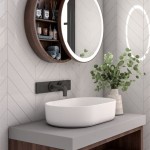How To Remove a Glued Mirror From a Wall
Mirrors, often affixed to walls using adhesives, can present a challenge when removal is required. Whether due to renovations, damage, or aesthetic changes, understanding the proper techniques for removing a glued mirror is crucial to minimize damage to both the mirror itself and the underlying wall surface. Several methods exist, each with its own advantages and disadvantages, and the success of any method depends on the type and strength of adhesive used, as well as the composition of the wall. This article outlines various strategies for safely removing a glued mirror, emphasizing preparation, execution, and post-removal repair.Prior to initiating any removal process, careful assessment of the situation is paramount. Identify the type of wall upon which the mirror is mounted. Drywall, plaster, and concrete each react differently to adhesive removal techniques. Determine the extent to which the mirror is glued to the wall. Is it a few dabs of adhesive, or a full coating? This will significantly influence the time and effort required. Furthermore, consider the value of the mirror. If the mirror is valuable or antique, professional removal is strongly recommended to avoid irreversible damage. Understand that even with the most careful techniques, there's always a risk of breakage, especially for large or older mirrors.
Safety considerations are also of utmost importance. Always wear safety glasses to protect eyes from flying debris. Gloves are recommended to protect hands from sharp edges and potential chemical irritants if solvents are employed. Ensure adequate ventilation, particularly if using solvents, to prevent inhalation of harmful fumes. Clear the work area of obstructions and protect the floor with drop cloths or plastic sheeting to catch any falling fragments or adhesive residue.
Preparation: Gathering Necessary Tools and Materials
Successful mirror removal relies heavily on having the right tools and materials readily available. The specific tools required will depend on the chosen removal method, but a general list includes:
*Safety Glasses and Gloves:
Essential for personal protection. *Putty Knife or Scraper:
A thin, flexible putty knife or scraper is needed to gently separate the mirror from the wall. Opt for plastic or nylon scrapers to minimize scratching, especially if the mirror is valuable. *Piano Wire or Cheese Wire:
Useful for "cutting" through the adhesive behind the mirror, particularly if the adhesive is applied extensively. Handles or loops at each end of the wire will improve grip and control. *Heat Gun or Hair Dryer:
Applying heat can soften the adhesive, making it easier to separate the mirror. A heat gun provides more concentrated heat, but a hair dryer can be a safer option for beginners. *Solvent (Optional):
Specific solvents like mineral spirits, Goo Gone, or adhesive remover may help dissolve certain types of adhesives. Test the solvent in an inconspicuous area first to ensure it doesn't damage the mirror's backing or the wall's finish. *Hammer and Wood Block (Optional):
For gently tapping the putty knife behind the mirror. Use this sparingly and with extreme caution. *Shims (Plastic or Wood):
Small, thin shims can be inserted into the gap created during separation to help maintain the progress and prevent the mirror from re-adhering. *Drop Cloths or Plastic Sheeting:
To protect the floor from debris and adhesive residue. *Painter's Tape:
To secure the mirror and prevent it from falling once partially detached. *Level:
To ensure shims are evenly placed. *Cleaning Supplies:
To remove any adhesive residue left on the wall after the mirror is removed. *Wall Repair Materials:
Spackle, drywall compound, sandpaper, and primer for repairing any damage to the wall.Method 1: Using a Putty Knife and Gentle Prying
This method is best suited for mirrors that are attached with a relatively small amount of adhesive. The key is to proceed slowly and patiently, applying gentle pressure to avoid cracking the mirror or damaging the wall.
Begin by carefully inserting the putty knife between the mirror and the wall at one of the corners. Apply gentle pressure, wiggling the knife to work it further behind the mirror. If the adhesive resists, try tapping the putty knife lightly with a hammer and wood block. Exercise extreme caution to avoid shattering the mirror.
Once the putty knife is inserted a sufficient distance, gently pry the mirror away from the wall. Insert shims into the gap as you progress to maintain the separation and prevent the mirror from re-adhering. Continue working around the perimeter of the mirror, gradually loosening the adhesive. If you encounter significant resistance, try applying heat with a hair dryer or heat gun to soften the adhesive.
Once the mirror is sufficiently loosened, use painter's tape to secure it to the wall to prevent it from falling. Carefully detach the mirror completely, supporting its weight. Have a helper available if the mirror is large or heavy. Place the mirror on a protected surface. Clean the wall to remove any remaining adhesive residue.
Method 2: Employing Piano Wire or Cheese Wire
For mirrors attached with a more substantial amount of adhesive, using piano wire or cheese wire can be an effective way to "cut" through the adhesive. This method requires more patience and careful handling to avoid scratching the mirror or damaging the wall.
Start by gently creating a small gap between the mirror and the wall at one of the corners using a putty knife. Insert the piano wire or cheese wire into the gap, threading it behind the mirror. Holding the ends of the wire with gloves or using handles, gently saw back and forth, working the wire through the adhesive. Maintain a consistent, slow pace to avoid overheating the wire or putting too much stress on the mirror.
As you progress, insert shims into the gap to maintain the separation. Continue sawing until you have worked the wire around the entire perimeter of the mirror. Be mindful of the wire's path and avoid applying excessive pressure that could cause the mirror to crack.
Once the wire has cut through the adhesive, use painter's tape to secure the mirror and prevent it from falling. Carefully detach the mirror completely, supporting its weight. Place the mirror on a protected surface. Clean the wall to remove any remaining adhesive residue.
Method 3: Utilizing Heat and Solvents
This method combines the application of heat to soften the adhesive with the use of solvents to dissolve it. It's best suited for situations where the adhesive is particularly stubborn or difficult to remove using other methods. However, it requires careful execution to avoid damaging the mirror, the wall, or posing a safety hazard with the solvents.
Begin by applying heat to the edge of the mirror using a heat gun or hair dryer. Keep the heat source moving to avoid overheating any one area, which could crack the mirror. The goal is to soften the adhesive without damaging the mirror or the wall finish.
While the adhesive is warm, carefully insert a putty knife between the mirror and the wall. Gently pry the mirror away from the wall, creating a small gap. Apply a small amount of solvent to the gap, allowing it to penetrate the adhesive. Test the solvent in an inconspicuous area first to ensure it doesn't damage the mirror's backing or the wall's finish. Common solvents include mineral spirits, Goo Gone, or specialized adhesive removers.
Allow the solvent to dwell for a few minutes, giving it time to dissolve the adhesive. Continue working around the perimeter of the mirror, applying heat and solvent as needed. As the adhesive softens, gently pry the mirror away from the wall, using shims to maintain the separation. Be patient and avoid forcing the mirror, as this could cause it to break or damage the wall.
Once the mirror is sufficiently loosened, use painter's tape to secure it and prevent it from falling. Carefully detach the mirror completely, supporting its weight. Place the mirror on a protected surface. Thoroughly clean the wall to remove any remaining adhesive residue. Ensure proper ventilation when using solvents.
After removing the mirror, the wall will likely exhibit adhesive residue and potential damage. Carefully scrape away any remaining adhesive using a putty knife. Avoid gouging the wall surface. If necessary, use a solvent to soften the adhesive before scraping, following the same precautions as outlined above.
Once the adhesive is removed, assess the wall for any damage. Small holes or imperfections can be filled with spackle or drywall compound. Apply the compound according to the manufacturer's instructions, allowing it to dry completely before sanding smooth. Use fine-grit sandpaper to blend the repaired areas with the surrounding wall surface. Prime the repaired areas with a suitable primer before painting to ensure proper adhesion of the paint. Finally, paint the entire wall or the repaired areas to match the existing color. Blending techniques may be required to ensure a seamless finish, especially if the original paint has faded.
Regardless of the chosen method, patience and care are essential for successfully removing a glued mirror from a wall. By following these guidelines and taking appropriate precautions, individuals can minimize the risk of damage to both the mirror and the wall and restore the surface to its original condition or prepare it for future use.

How To Remove A Mirror Glued The Wall Forbes Home

How To Remove A Bathroom Mirror Lowe S

How To Safely And Easily Remove A Large Bathroom Builder Mirror From The Wall Site Title

How To Safely And Easily Remove A Large Bathroom Builder Mirror From The Wall Site Title

How To Remove A Wall Mirror Diy Weekend Project Rustic Mirrors Black

Removing A Glued On Mirror From Wall

How To Remove Mirror Off Wallsafely

How To Safely And Easily Remove A Large Bathroom Builder Mirror From The Wall Site Title

How To Remove A Glued Bathroom Mirror From The Wall

How To Remove A Bathroom Mirror Lowe S








